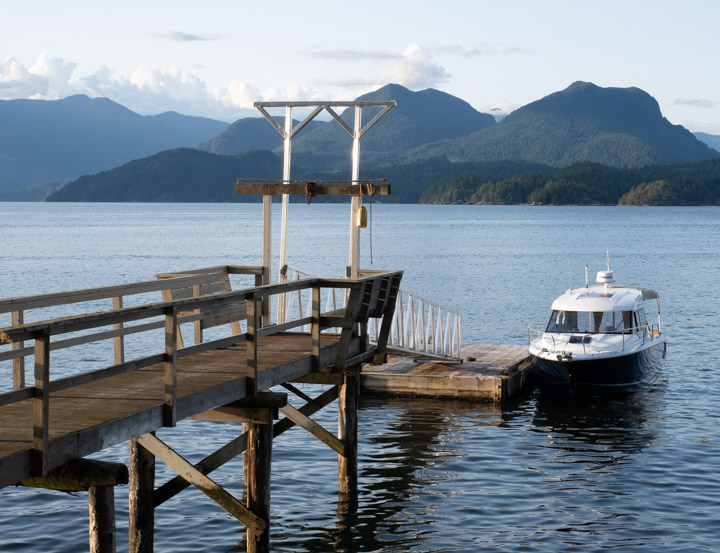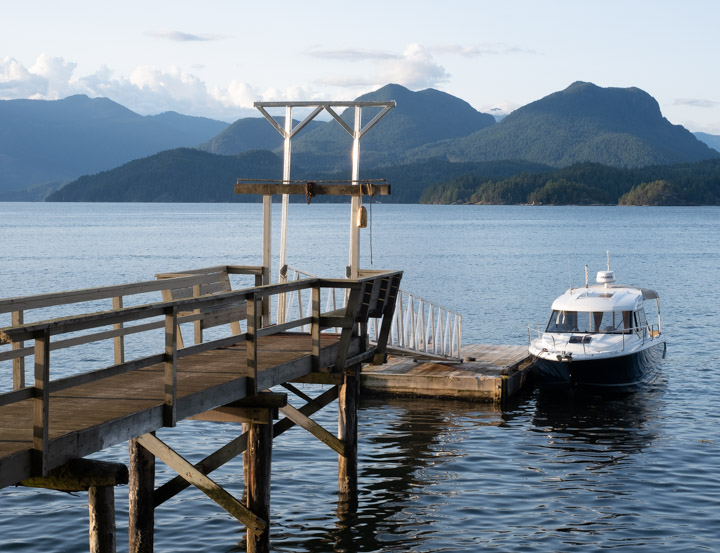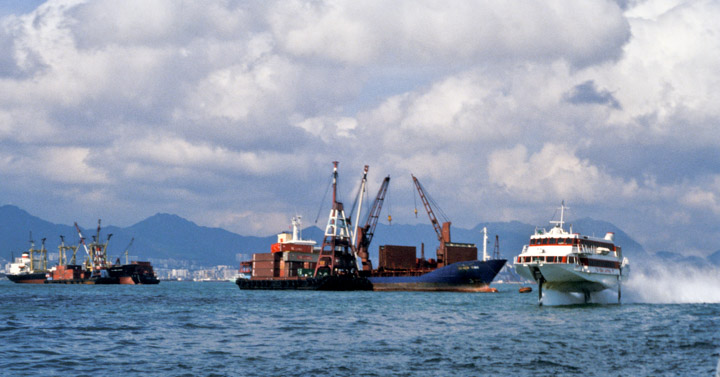
I was standing on a floating dock on a Pacific-ocean inlet, a place where it’s obvious why motorboats are such an environmental disaster. Fortunately lots of other people have noticed too and it looks increasingly that more people will be able to enjoy Messing About In Boats without feeling like they’re making Greta Thunberg justifiably angry at them.
Hm, this piece got kind of long. Spoiler: I’m here mostly to talk about electric hydrofoil boats from Candela, in Sweden, which look like a genuinely new thing in the world. But I do spend a lot of words setting up (separately) the electric-boat and hydrofoil propositions, which you can skip over if you’d like.
Background · Last year I wrote about personal decarbonization, noting that our family works reasonably hard at reducing our carbon load, with the exception being that we still have a power boat that burns an absurd amount of fossil fuel for each km of the ocean that you cross.
Electric boats · Separately, back in 2019 I wrote a little survey of electric-boat options; my conclusion was that it shouldn’t be too long before they’re attractive for the “tugboat” flavor of pleasure boats. Which is perfectly OK unless you want to cover some distance and get there fast.
There’s been quite a bit of action in the electric-boat space. Here are some companies: VisionMarine Technologies (formerly the Canadian Electric Boat Company), Rand Boats, Greenline Yachts, Zin Boats, and then here’s Electrek’s electric-boats articles. If you like boats at all there’ll be pictures and videos in that collection that you’ll enjoy.
A lot of these are interesting, but (near as I can tell) none of them come close to combining the comfort, capacity, speed, and range that my family’s current Jeanneau NC 795 does.
But in the wake of Tesla, enough people are getting interested in this problem that it’s a space to watch.
That float · Here’s a picture of the float (and the boat). I was sitting down there on a lawn-chair enjoying the view, good company, and an adult beverage.
What I noticed was that every time a motorboat went by, the wake really shook us up on the float. That float is a bug honking chunk of wood, something like ten by twenty feet, and those powerboat wakes toss it around like a toy.
Which is to say, moving a boat of any size along at any speed throws a whole lot of water around. My impression is that most of the energy emitted by the burning fossil fuel goes into pushing water sideways, rather than fiberglass forward.
Let me quote from that Electric Boats piece: “There are two classes of recreational motorboat: Those that go fast by planing, and those that cruise at hull speed, which is much slower and smoother.”
Both of those processes involve pushing a lot of water sideways. And it turns out that my assertion is just wrong because there’s a third approach: the Hydrofoil. It’s not exactly a new idea either, the first patent was filed in 1869, and while they’re not common, you do see them around. In fact, here’s a picture of one I took in Hong Kong Harbour, of the fast ferry that takes high-rollers over to the casinos in Macau.
If it looks a little odd that’s because I took it in 1994, with a film camera.
Hydrofoil sailing boats are a thing, including the AC75 design that was used in the most recent America’s Cup, probably the world’s highest-profile sailing race. These things are fast, coming close to 100 km/h. I strongly recommend this video report.
Then there’s the Vestas Sailrocket 2, which currently holds the world record for the highest sustained speed over 500m: 66.45 knots, which is 121.21 km/h. There’s a nice write-up in Wired.
Also check out the Persico 69F, something like the A75 only anyone can buy one. Here’s a story in Sailing World that has a lot of flavor.
Hydrofoil + electrons = Candela · I guess it’s pretty obvious where I’ve been heading: What about an electric hydrofoil motorboat? It turns out that there’s an outfit called Candela which is building exactly such a thing near Stockholm; their first boat is called the C-7. I reached out and got into an email dialog with Alexander Sifvert, their Chief Revenue Officer. It’s remarkably easy to strike up such a conversation when you open with “I’m a boater and an environmentalist and well-off.”
The idea is that you make an extremely light hull out of carbon fibre, give it an electrical drive-train, and put it on software-controlled hydrofoils that lift the hull out of the water and adjust continuously to waves and currents, to give you a smooth, silent, fast, ride. They claim that the foils experience only a quarter of the water drag compared to any conventional hull going fast — the typical cruising speed is 20kt or 37 km/h. So with a 40kWh battery pack like that in a BMW i3, they get 90+km of range at cruising speed.
Obviously there’s vastly less wake, and once you’re out at sea the operating cost is rounding error compared to what you pay to fill up the average motorboat’s huge fuel tank. Also, experience from the electric-car world suggests that the service costs on a setup like this should be a lot less over the years.
All this on top of the fact that your carbon load is slashed dramatically, more if your local electricity is green but still a lot. I also appreciate the low wake and silence — at our cabin, overpowered marine engines going too fast too close to shore are a real quality-of-life issue.
The Candela website is super-ultra-glossy and not terribly information-dense. Soak up some of the eye-candy then jump to the FAQ.
But there are terrific videos. The one that most spoke to me was this, of a C-7 and a conventional motorboat running side by side in rough water, which we experience a lot of up here in the Pacific Northwest. Here we have a famous powerboat racer (yes, there are such things) taking a C-7 out for a spin. And here we have a C-7 cruising along beside one of those insanely-fast hydrofoil sailboats from Persico.
I’m seriously wondering if this is the future of recreational motorboating.
Would I get one? · Well, it’s a good thing the C-7 doesn’t use much fuel, because it’s really freaking expensive, like three times the price of my nice little Jeanneau. Which should not be surprising in a product that is built out of carbon fibre, by hand, “serially” they say, in a nice neighborhood near Stockholm.
In any case, I wouldn’t buy the C-7 model because it’s built for joyriding and sunbathing, and we use our boat for commuting to the cottage and as Tim’s office. Mr Sifvert agreed, suggested they might have something more suitable in the pipeline and wondered if I’d like to sign an NDA (I declined, no point hearing about something I can’t buy or write about right now). Separately, I note that they’re also working on a municipal-ferry product.
I’ll take a close look when the product Mr Sifvert hinted at comes out. But at that price point, I’ll need to try it out — I gather Candela is happy to give you a sea trial if you’re willing to visit Stockholm. Which actually doesn’t sound terrible.
Independent testimony would be nice too. Which is a problem; as I noted in my Jeanneau review (while explaining why I posted it), boats are a small market with a tight-knit community and truly impartial product evaluations by experts are hard to come by.
Futures · The core ideas behind the Candela C-7 aren’t that complicated: Electric powertrain, battery, hydrofoils, software trim control. Because of electric cars there’s a lot of battery and electrical-engine expertise about. Hydrofoils aren’t a new technology either. So getting the software right is maybe the crucial secret sauce?
Thing is, as a citizen of the planet, I’d like to see the roads full of electric cars — this is definitely going to happen — and the waterways full of boats that look like what Candela is building. Which won’t happen at the current price point, but I’m not convinced that can’t be driven down to what the boating world sees as a “mass-market” level. I’ve no way to know whether that will happen. I sure hope so.
如有侵权请联系:admin#unsafe.sh

